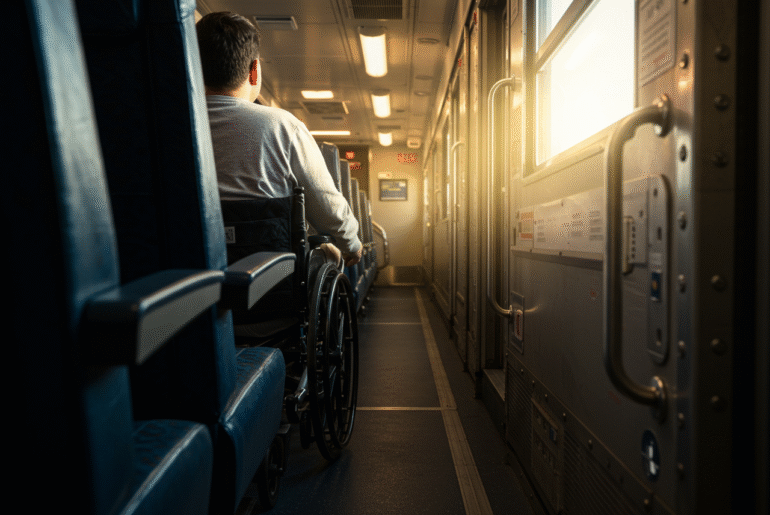This article may contain references to products or services from one or more of our advertisers or partners. We may receive compensation when you click on links to those products or services. Nonetheless, our opinions are our own.
The information presented in this article is accurate to the best of our knowledge at the time of publication. However, information is subject to change, and no guarantees are made about the continued accuracy or completeness of this content after its publication date.
Amtrak Accessibility Guide for Travelers with Disabilities
Traveling by train across the United States is a rewarding experience, offering scenic views and a relaxed pace that many travelers prefer to air travel. If you or a loved one has a disability, understanding Amtrak’s accessibility services can make the journey much easier and more comfortable. Amtrak has implemented a range of accessibility options that cover booking, boarding, onboard accommodations, and station services. This guide explains those services and offers practical tips to help you plan a wheelchair-friendly trip from start to finish.
Booking Accessible Tickets
Reserving an accessible ticket on Amtrak is straightforward, and the company provides multiple booking channels to suit different needs. You can select wheelchair spaces and accessible seating and request boarding assistance when booking through the website or the Amtrak app. For complex needs, such as accessible bedrooms on long-distance routes, oxygen equipment, or unusual mobility aids, Amtrak offers phone and live-chat support to confirm arrangements. Always verify your special needs at booking and keep a record of any confirmations to avoid last-minute issues.
Online or App Reservations
The Amtrak website and mobile app include options to choose wheelchair spaces and accessible seating during reservation, and they allow you to flag boarding assistance needs. These tools show available accommodations and help you secure the correct seat type before you arrive at the station. Using the app can also speed up check-in and make it easier to communicate last-minute changes or questions. If you prefer human support, pair an online booking with a phone call to confirm details and special requests.
Accessibility Hotline and Special Needs
For specialized requests or complicated travel plans, contact Amtrak’s accessibility support at 1-800-USA-RAIL (1-800-872-7245) or use the live chat on Amtrak’s website. Agents can assist with matters such as accessible bedrooms on long-distance trains, oxygen or medical equipment policies, and coordination of station staff assistance. Calling ahead is strongly recommended for long-distance or overnight routes to ensure the right accommodations are reserved and confirmed. Keep a copy of any agent reference numbers or written confirmations for the day of travel.
Station Accessibility
Station accessibility varies across the Amtrak network, so it is important to check station features before you travel and to plan accordingly. Most larger stations offer ramps, elevators, accessible restrooms, and designated drop-off zones, while smaller or historic stations may have limited access or require alternate arrangements. Amtrak’s station pages indicate available services and accessibility details, and you can also call the station directly if you need clarification. When in doubt, ask for Red Cap or station staff assistance prior to arrival so your experience is smooth.
Parking and Dropping-off
Many Amtrak stations provide accessible parking spaces and clearly marked drop-off zones close to station entrances for easier access. If you intend to be dropped off, please verify the drop-off procedures and locations for the specific station to ensure drivers can stop safely. Accessible parking spaces often fill early at busy stations, so allow extra time or consider public transit connections if feasible. If you require assistance from curb to platform, request staff help in advance so a team member is available.
Station Layout and Staff Assistance
Larger stations typically feature elevators, ramps, tactile guidance, accessible restrooms, and staff trained to assist passengers with mobility needs. Station staff can assist with luggage, guide you to platforms, and coordinate boarding assistance such as wheelchair lifts or bridge plates when available. Free Red Cap baggage assistance is offered at many major stations and can be requested to help move luggage between vehicle and platform. Always confirm the availability of specific services for your departure and arrival stations before travel.
Voted "Best Overall Budgeting App" by Forbes and WSJ
Monarch Money helps you budget, track spending, set goals, and plan your financial future—all in one app.
Get 50% OFF your first year with code MONARCHVIP
Onboard Accessibility
Amtrak’s onboard accessibility features aim to provide comfortable and practical travel for passengers with disabilities, especially on routes with modern equipment. Wheelchair spaces are reserved near accessible restrooms and exits, and priority seating is available to help make boarding and movement easier. Boarding aids, such as wheelchair lifts and bridge plates, are used at many stations to bridge the gap between platforms and trains, and onboard staff can assist with stowing mobility aids and luggage. For overnight or long-distance trips, accessible bedroom and restroom layouts vary, so confirm exact car types and accessibility details when you reserve.
Boarding and Disembarking
At many stations, wheelchair lifts, bridge plates, and coordinated staff assistance make boarding and disembarking easier; however, the availability of these services can vary by location. Station staff normally arrange the use of lifts or bridge plates where platforms and equipment require them, and they will guide you through the boarding process. If you need help moving from the platform into the train, notify Amtrak staff ahead of time to ensure someone is present when you arrive. For transfers at intermediate stations, verify that both the arriving and departing platforms can accommodate your mobility equipment.
Wheelchair Spaces and Priority Seating
Wheelchair spaces are reserved and positioned near accessible restrooms and train exits to reduce walking distances and improve convenience during the trip. Priority seating provides quicker access to assistance and a more comfortable experience for passengers who need it. If you use a mobility device, confirm the dimensions and securement process with Amtrak to ensure your equipment fits the reserved space safely. On many routes, staff will help secure wheelchairs in designated areas to minimize movement during travel.
Service Animals
ADA-qualified service animals are welcome on Amtrak and travel free of charge when they meet the criteria for service animals under ADA rules. It is important to be prepared with any documentation Amtrak or connecting carriers may request and to ensure the animal can be controlled in busy station environments. Notify Amtrak in advance if your service animal requires space considerations or if you anticipate needing staff assistance related to the animal. Service animals are not considered pets and are accommodated to support traveler independence.
Connections
If your itinerary includes connections to other trains or buses, confirm the accessibility of each connecting service in advance to avoid surprises or last-minute changes. Many transit providers and regional partners have their own accessibility rules, so check those policies and the physical accessibility of connecting stations or stops. Allow extra time between connections to account for assisted boarding and possible platform transfers. When possible, plan connections with extra buffer time and confirm arrangements with both carriers.
Accessibility Limitations
Despite steady improvements, some limitations still exist across the Amtrak network and its equipment, so plan with realistic expectations. Not every station is fully ADA compliant, and smaller or historic stations often have partial access or require alternative boarding procedures. Older train cars and certain regional routes may lack the most recent accessibility features or spatial accommodations. Please inform Amtrak of any special needs well in advance, allowing staff to suggest practical solutions and document any limitations for your trip.
Travel Planning Tips
Planning ahead can significantly enhance the comfort and ease of your Amtrak journey, particularly for those who utilize mobility aids or require additional support. Reserve accessible seating and spaces as early as possible to secure the best options and to give staff time to coordinate services. Arrive 30 to 45 minutes before departure when you require assistance so station staff can prepare boarding equipment and help you safely. Confirm accessibility for all connecting services and keep Amtrak contact details handy for last-minute questions or adjustments.
FAQs
Can I bring mobility equipment on Amtrak?
- Yes. Amtrak allows wheelchairs, scooters, and most mobility aids, but you should confirm space and securement needs when booking to ensure safe transport.
Are all Amtrak stations fully ADA compliant?
- Most major stations meet ADA standards, but some smaller or historic stations may still have accessibility gaps; check station details in advance.
How early should I arrive for boarding with assistance?
- Arrive at least 30 to 45 minutes before departure to give staff time to set up lifts, bridge plates, or any other boarding assistance you require.
Can my service animal travel with me?
- Yes. ADA-qualified service animals travel free of charge and are accommodated on board, though you should notify Amtrak ahead of time if special arrangements are needed.
Conclusion
Amtrak accessible travel makes long-distance and regional train journeys possible for passengers who use wheelchairs or who need other accessibility supports. This guide offers verified, practical steps you can use when booking, arriving at the station, boarding, and riding to help ensure a smoother trip. While some older stations and equipment may still present challenges, planning ahead and confirming services with Amtrak reduces most surprises. Use the accessibility hotline, reserve the correct seating early, and allow extra time at stations to make your travel day calmer and more predictable. These steps let you focus on the scenery and comfort that rail travel provides rather than on logistics.

Reviewed and edited by Albert Fang.
See a typo or want to suggest an edit/revision to the content? Use the contact us form to provide feedback.
At FangWallet, we value editorial integrity and open collaboration in curating quality content for readers to enjoy. Much appreciated for the assist.
Did you like our article and find it insightful? We encourage sharing the article link with family and friends to benefit as well - better yet, sharing on social media. Thank you for the support! 🍉
Article Title: Amtrak Travel Guide for Disabled Passengers
https://fangwallet.com/2025/08/26/amtrak-travel-guide-for-disabled-passengers/The FangWallet Promise
FangWallet is an editorially independent resource - founded on breaking down challenging financial concepts for anyone to understand since 2014. While we adhere to editorial integrity, note that this post may contain references to products from our partners.
The FangWallet promise is always to have your best interest in mind and be transparent and honest about the financial picture.
Become an Insider

Subscribe to get a free daily budget planner printable to help get your money on track!
Make passive money the right way. No spam.
Editorial Disclaimer: The editorial content on this page is not provided by any of the companies mentioned. The opinions expressed here are the author's alone.
The content of this website is for informational purposes only and does not represent investment advice, or an offer or solicitation to buy or sell any security, investment, or product. Investors are encouraged to do their own due diligence, and, if necessary, consult professional advising before making any investment decisions. Investing involves a high degree of risk, and financial losses may occur including the potential loss of principal.
Source Citation References:
+ Inspo
There are no additional citations or references to note for this article at this time.












































